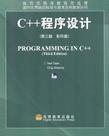C++程序设计
出版时间:2006-3 出版社:高等教育出版社 作者:戴利 页数:719 字数:720000
Tag标签:无
内容概要
本书引进工作是在教育部高等教育司和高教社的共同组织下,由国内信息科学技术领域的专家、教授广泛参与,在对大量国外教材进行多次遴选的基础上,参考了国内和国外著名大学相关专业的课程设置进行系统引进的。其中,John
Wiley公司出版的贝尔实验室信息科学研究中心副总裁Silberschatz教授的经典著作《操作系统概念》,是我们经过反复谈判,做了很多努力才得以引进的。William
StaUings先生曾编写了在美国深受欢迎的信息科学技术系列教材,其中有多种教材获得过美国教材和学术著作者协会颁发的计算机科学与工程教材奖,这批引进教材中就有他的两本著作。留美中国学者Jiawei
Han先生的《数据挖掘》是该领域中具有里程碑意义的著作。由达特茅斯学院Thomas
Cormen和麻省理工学院、哥伦比亚大学的几位学者共同编著的经典著作《算法导论》,在经历了11年的锤炼之后于2001年出版了第二版。目前任教于美国Massachusetts大学的James
Kurose教授,曾在美国三所高校先后l0次获得杰出教师或杰出教学奖,由他主编的《计算机网络》出版后,以其体系新颖、内容先进而倍受欢迎。在努力降低引进教材售价方面,高等教育出版社做了大量和细致的工作。《C++程序设计》体现了权威性、系统性、先进性和经济性等特点。
作者简介
作者:(美国)戴利 (美国)维姆斯
书籍目录
Preface
1 Ocerview of Programming and Problem Solving
1.1 Overview of Programming
How Do We Write a Program?
1.2 What is a Programming Language?
1.3 What is a Computer?
1.4 Problem-Solving Techniques
Ask Questions 15
Look For Things That Are Familiar
Solve by Analogy
Means-Ends Analysis
Divide and Conquer
The Building-Block Approach
Merging Solutions
Mental Blocks: The Fear of Starting
Algorithmic Problem Solving
Summary
Quick Check
Exam Preparation Exercises
Programming Warm-Up Exercises
2 C++ Syntax and Semantics, and the Program
Development Process
2.1 The Elements of C++ Programs
Syntax and Semantics
Syntax Templates
Naming Program Elements: Identifiers
Data and Data Types
Data Storage
The char Data Type
The string Data Type
Naming Elements: Declarations
Taking Action: Executable Statements
Beyond Minimalism: Adding Comments to a Program
2.2 Program Construction
Blocks (Compound Statements)
The C++ Preprocessor
An Introduction to Namespaces
2.3 More About Output
Creating Blank Lines
Inserting Blanks Within a Line
Programming Example
esting and Debugging
Summary
Quick Check
Exam Preparation Exercises
Programming Warm-Up Exercises
Programming Problems
Programming Example Follow-Up
3 Numeric Types,Expressions,and Output
4 Program Input and the Software Design Process
5 Conditions,Logical Expressions,and Selection Control
Structures
6 Looping
7 Functions
8 Scope,Liftime,and More on Functions
9 Additional Control Structures
10 Simple Data Types:Built-In and User-Defined
11 Structured Types,Date Abstraction,and Classes
12 Arrays
13 Array-Based Lists
14 Object-Orinted Software Development
15 Recursion
Glossary
Answers to Selected Exercises
Appendices
Index
章节摘录
版权页: 插图: Much of human behavior and thought is characterized by logical sequences. Since infancy, you have been learning how to act, how to do things. And you have learned to expect certain behavior from other people. On a broader scale, mathematics never could have been developed without logical sequences of steps for solving problems and proving theorems. Mass production never would have worked without operations taking place in a certain order. Our whole civilization is based on the order of things and actions. We create order, both consciously and uncon-sciously, through a process we call programming. This book is concerned with the programming of one of our tools, the computer. Just as a concert program lists the order in which the players perform pieces, a computer program lists the sequence of steps the computer performs.From now on, when we use the words program-ming and program, we mean computer programming and computer program. The computer allows us to do tasks more effi-ciently, quickly, and accurately than we could by hand-if we could do them by hand at all. In order to use this powerful tool, we must specify what we want done and the order in which we want it done. We do this through programming.How Do We Write a Program? To write a program, we must go through a two-phase process: problem solving and implementation (see Figure 1-1). Problem-Solving Phase 1. Analysis and specification. Understand (define) the problem and what the solution must do. 2. General solution (algorithm). Develop a logical sequence of steps that solves the problem. 3. Verify. Follow the steps exactly to see if the solution really does solve the problem. Implementation Phase 1. Concrete solution (program). Translate the algorithm into a programming lan- guage. 2. Test. Have the computer follow the instructions. Then manually check the results. If you find errors, analyze the program and the algorithm to determine the source of the errors, and then make corrections.Once a program has been written, it enters a third phase: maintenance.
编辑推荐
《C++程序设计》是本全英文读本。主要介绍了C++程序设计的内容。由教育部高等教育司推荐,是国外优秀信息科学与技术系列教学用书。值得大家注意。 《C++程序设计》的特点:权威性——教育等教育司推荐、教育部高等学校信息科学与技术引进教材专家组遴选。系统性——覆盖计算机专业主干课程和非计算机基础课程。先进性——著名计算机专家近两年的最新著作,内容体系先进。经济性——价格与国内自编教材相当,是国内引进教材价格最低的。一流的品质,优惠的价格。
图书封面
图书标签Tags
无
评论、评分、阅读与下载
用户评论 (总计0条)
相关图书
- Internet应用技术与HTML
- ATmega128单片机应用与开发实例
- PIC单片机初级教程
- 嵌入式单片机技术
- SoC技术原理与应用
- 计算机病毒与反病毒技术
- 计算机安全防护即时通
- 计算机组装与维修
- 2天精通装机、重装系统与维修
- 计算机硬件技术基础
- 计算机数学基础
- 计算机组织与系统结构
- 计算机安装、调试与维修
- 计算机原理
- 算法设计与分析
- 计算机组装与维护
- 计算机组装与维护
- 操作系统
- Jbuilder网络编程
- Visual Basic软件开发技术
- C++程序设计
- 微型计算机磁盘操作系统
- 程序设计职业核心能力课程程序设计初步-(C#.NET)
- Office 2003应用技巧600招
- 面向对象方法与技术基础
